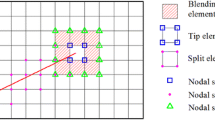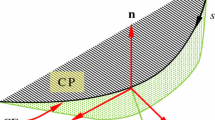Abstract
In this contribution, the microscopic fracture mechanism and extension criterion for mixed type crack in ductile material under plane mixed mode loading are investigated in details. A universal extension criterion for the mixed type crack, i.e. the crack propagates along the direction of the maximum gradient of equivalent stress, is suggested. This new criterion is used to predict the propagation direction of mixed type crack, showing a good agreement with other theories for different types of mode mixity. Moreover, the numerical verification is also carried out for the case of an edge crack with different mixed mode loadings. Finally, a potential application to three-dimensional fracture in the ductile material induced by holes is also discussed.
Similar content being viewed by others
References
Erdogan, F. and Sih, G.C., On the crack extension in plates under plane loading and transverse shear. Transactions of the ASME, Journal of Basic Engineering. 1963, 85D: 519–527.
Sih, G.C., Strain-energy-density factor applied to mixed mode crack problems. International Journal of Fracture. 1974, 10(3): 305–321.
Nuismer, R.J., An energy release rate criterion for mixed mode fracture. International Journal of Fracture, 1975, 11: 245–250.
Wu, C.H., Fracture under combined loads by maximum energy release rate criterion. Transactions of the ASME, Journal of Applied Mechanics, 1978, 45: 553–558.
Kfouri, A.P. and Brown M.W., A fracture criterion for cracks under mixed mode loading. Fatigue and Fracture of Engineering Materials and Structures, 1995, 18(9): 959–969.
Shafique, M.A. and Marwan, K., Analysis of mixed mode crack initiation angles under various loading conditions. Engineering Fracture Mechanics, 2000, 67: 397–419.
Theocaris, P.S. and Andrianopoulos, N.P., The Miseselastic-plastic boundary as the core region in fracture criteria. Engineering Fracture Mechanics, 1982a, 16(3): 425–432.
Theocaris, P.S. and Andrianopoulos, N.P., The T-criterion applied to ductile fracture. International Journal of Fracture, 1982b, 20: R125–130.
Theocaris, P.S., Discussion of ‘On the use of the T-criterion in fracture mechanics’ by Yehia, N.A.B.. Engineering Fracture Mechanics, 1986, 24(3): 371–382.
Ukadgaonker, V.G. and Awasare, P.J., A new criterion for fracture initiation. Engineering Fracture Mechanics, 1995, 51(2): 265–274.
Kahn, S.M.A. and Khraisheh, M.K., Analysis of mixed mode crack initiation angles under various loading conditions. Engineering Fracture Mechanics, 2000a, 67(5): 397–419.
Theocaris, P.S., Kardomateas, G.A. and Andrianopoulos, N.P., Experimental study of the T-criterion in ductile fracture. Engineering Fracture Mechanics, 1982, 17(5): 439–447.
Williams, J.G. and Ewing, P.D., Fracture under complex stress-the angled crack problem. International Journal of Fracture Mechanics, 1972, 8(4): 441–446.
Ewing, P.D. and Williams, J.G., The fracture of spherical shells under pressure and circular tubes with angled cracks in torsion. International Journal of Fracture, 1974, 10(4): 537–544.
Maiti, S.K. and Smith, R.A., Comparison of the criteria for mixed mode brittle fracture based on the pre-instability stress-strain field, part I: slit and elliptical cracks under uniaxial tensile loading. International Journal of Fracture, 1983, 23: 281–295.
Stanislav, S. and Zdenek, K., Two parameter fracture mechanics: Fatigue crack behavior under mixed mode conditions. Engineering Fracture Mechanics, 2008, 75: 857–865.
Golos, K. and Wasiluk, B., Role of plastic zone in crack growth direction criterion under mixed mode loading. International Journal of Fracture, 2000, 102: 341–353.
Wasiluk, B. and Golos, K., Prediction of crack growth direction under plane stress for mixed-mode I and II loading. Fatigue and Fracture of Engineering Materials and Structures, 2000, 23: 381–386.
Kahn, S.M.A. and Khraisheh, M.K., A new criterion for mixed mode fracture initiation based on the crack tip plasticity. International Journal of Plasticity, 2004, 20: 55–84.
Kahn, S.M.A. and Khraisheh, M.K., The anisotropic R-criterion for crack initiation. Engineering Fracture Mechanics, 2008, 75: 4257–4278.
Bian, L.C. and Kim, K.S., The minimum plastic zone radius criterion for crack initiation direction applied to surface cracks and through-cracks under mixed mode loading. International Journal of Fatigue, 2004, 26: 1169–1178.
Hutchinson, J.W., Plane stress and strain fields at the crack tip. Journal of Mechanics and Physics of Solids, 1968a, 16: 337–347.
Hutchinson, J.W., Singular behavior at the end of a tensile crack in a hardening material. Journal of Mechanics and Physics of Solids, 1968b, 16: 13–31.
Rice, J.R. and Rosegren, G.F., Plane strain deformation near a crack tip in a power-law hardening material. Journal of Mechanics and Physics of Solids, 1968, 16: 1–12.
Wang, F.W. and Chen, Y.H., A new find in experimental research on coalescence between two holes in aluminum alloy strip under cyclic tensile loading. Journal of Xi’an Jiaotong University, 2009, 43(1): 125–128.
Author information
Authors and Affiliations
Corresponding author
Additional information
Project supported by the Natural Science Foundation of Shannxi (No. 2005A19), the Open Foundation of Engineering Key Laboratory of Disaster Prevention and Structural Safety, Guangxi Univ. (No. 2008TMKF004) and the National Natural Science Foundation (Nos. 10932007 and 11172228).
Rights and permissions
About this article
Cite this article
Zuo, H., Feng, Y. A Universal Crack Extension Criterion Based on the Equivalent Stress Gradient: I. Theory and Numerical Verification. Acta Mech. Solida Sin. 25, 100–110 (2012). https://doi.org/10.1016/S0894-9166(12)60011-1
Received:
Revised:
Published:
Issue Date:
DOI: https://doi.org/10.1016/S0894-9166(12)60011-1




